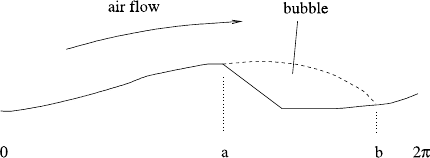Fowler A. Mathematical Geoscience
Подождите немного. Документ загружается.


300 5 Dunes
and thus ∂τ
(0)
3
/∂z =0, where the overbar denotes the horizontal mean. Thus (with
τ
(0)
3
=1 from the condition at z =∞), u
0
is determined via
u
2
0
+2w
(0)2
x
=
1
κ
2
z
2
. (5.158)
The non-zero quantity 2
w
(0)2
x
represents the form drag due to the surface topogra-
phy. Note that the logarithmic behaviour of u
0
near z =0 is unaffected by this extra
term, and we can take
u
0
=
1
κ
lnz +O
z
2
as z →0. (5.159)
In particular, since p
(0)
≈p
0
+p
(0)
z
|
εs
(z −εs) as z → εs, and p
(0)
z
|
εs
=−w
(0)
x
|
εs
=
−s
xx
,wehave
u
(0)
∼−p
0
+
1
κ
lnz +s
xx
(z −εs) +O
z
2
as z →εs. (5.160)
From (5.156), we now have
τ
(0)
3
=1 +3κ
2
z
2
u
0
w
(0)
x
+
∂Φ
∂x
, (5.161)
where we define
Φ =
x
−∞
2κ
2
z
2
w
(0)2
x
−w
(0)2
x
dx. (5.162)
Hence from (5.153),
u
(1)
+p
(1)
=
∂
∂z
3κ
2
z
2
u
0
w
(0)
+Φ
+τ
(0)
1
−
1
2
u
(0)2
+w
(0)2
+u
0
(z)ψ
(0)
+u
1
(z), (5.163)
where u
1
must be determined at O(ε
2
).
Now u
0
∼
1
κ
lnz +O(z
2
), Φ = O(z
2
), τ
(0)
1
= O(z), w
(0)
= s
x
+O(z), ψ
(0)
=
−s − zp
0
+ O(z
2
) (this last follows from manipulation of (5.154)). Therefore, as
z →0,
u
(1)
=−p
10
+3κs
x
−
1
2
s
2
x
+
−p
0
+
1
κ
lnz
2
+
1
κz
(−s −zp
0
) +u
1
+O(z), (5.164)
where p
10
=p
(1)
|
z=0
.
5.7.7 Determination of p
10
Define the Green’s function

5.7 Mixing-Length Model for Aeolian Dunes 301
K(x,z;ξ,ζ) =−
1
4π
ln
(x −ξ)
2
+(z −ζ)
2
+ln
(x −ξ)
2
+(z +ζ)
2
. (5.165)
We then have, for example,
p
(0)
=
ζ>0
K∇
2
p
(0)
−p
(0)
∇
2
K
dξ dζ
=
K
∂p
(0)
∂n
−p
(0)
∂K
∂n
ds
=−
∞
−∞
K
∂p
(0)
∂ζ
dξ =
∞
−∞
K
∂w
(0)
∂ξ
dξ =−
∞
−∞
w
(0)
∂K
∂ξ
dξ, (5.166)
whence we derive (5.150) for example; the integrals with respect to ξ are taken
along ζ =0.
Next, expanding (5.144) about z =0, we find
w
(1)
∼
su
(0)
x
as z →0. (5.167)
Putting
w
(1)
=s
x
u
0
+W, (5.168)
we deduce the condition
W =−(sp
0
)
x
on z =0, (5.169)
and from (5.152)
p
(1)
x
−W
z
=R,
p
(1)
z
+W
x
=S,
where
R =τ
(0)
1x
+τ
(0)
3z
−
u
(0)
u
(0)
x
+w
(0)
u
(0)
z
−s
x
u
0
,
S =τ
(0)
3x
−τ
(0)
1z
−
u
(0)
w
(0)
x
+w
(0)
w
(0)
z
+s
xx
u
0
.
Also
∇
2
p
(1)
=R
x
+S
z
, (5.170)
and it follows from using the Green’s function as in (5.166) that, after some manip-
ulation involving Green’s theorem,
p
(1)
=
ζ>0
(RK
ξ
+SK
ζ
)dξ dζ −
∞
−∞
K
ξ
Wdξ, (5.171)
and therefore
p
10
=
1
π
ζ>0
[(x −ξ)R(ξ,ζ)−ζS(ξ,ζ)]
(x −ξ)
2
+ζ
2
dξ dζ −
1
π
−
∞
−∞
(sp
0
)
ξ
dξ
ξ −x
. (5.172)

302 5 Dunes
5.7.8 Matching
Overall, then, the outer solution can be written, as z →0, in the form (using (5.160))
u ∼−p
0
+
1
κ
ln z +s
xx
(z −εs) +ε
−p
10
+3κs
x
−
1
2
s
2
x
−
1
2
p
2
0
+
p
0
κ
ln z
−
1
2κ
2
ln
2
z −
s
κz
−
p
0
κ
+u
1
. (5.173)
If we define
√
τ =1 +εA
1
+ε
2
A
2
+···, (5.174)
then (5.141) takes the form
u ∼A
1
+
1
κ
lnz +ε
−
s
κz
+
A
1
κ
ln z +A
2
+···, (5.175)
and the leading order term can be matched directly to that of (5.173) by choosing
A
1
=−p
0
. (5.176)
Using (5.176), (5.174) and (5.151), we have
τ ≈1 +
2ε
π
−
∞
−∞
s
ξ
dξ
x −ξ
, (5.177)
and this can be compared with (5.103). Whereas in (5.103) K(x) =0forx<0, the
kernel K(x) in (5.177) is proportional to 1/x for all x, and thus non-zero for x<0.
Consequently, there is no instability, and to find an instability we need to progress
to the next order term.
Unfortunately, the O(ε) terms do not match because the terms ±
p
0
κ
ln z in the
two expansions are not equal, and also because of the linear term in (5.173). In
order to match the expansions to O(ε), we have to consider a further, intermediate
layer: this is the shear layer we alluded to earlier.
5.7.9 Shear Layer
A distinguished limit exists when z =O(ε), and thus we put
z =εs +εζ, w =s
x
+ε[us
x
+W ],
η =εN, τ
1
=εT
1
,
u =−p
0
+
1
κ
ln(z −εs) +εv,
(5.178)

5.7 Mixing-Length Model for Aeolian Dunes 303
and from (5.173) and (5.141)(using(5.174) and (5.176)), we require
v ∼ s
xx
ζ −p
10
+3κs
x
−
1
2
s
2
x
−
1
2
p
2
0
−
p
0
κ
+
p
0
κ
lnεζ
+
u
1
−
1
2κ
2
ln
2
εζ
as ζ →∞,
v ∼A
2
−
p
0
κ
ln εζ as ζ →0.
(5.179)
It follows from (5.178) that
N =κ
2
ζ
2
∂u
∂ζ
,
T
1
=2N [u
x
−s
x
u
ζ
],
τ
3
=N
u
ζ
+εs
xx
+O
ε
2
,
u
x
+W
ζ
=0,
(u +p)
x
−s
x
p
ζ
=τ
3ζ
−ε[uu
x
+Wu
ζ
]+O
ε
2
,
p
ζ
=−εs
xx
+O
ε
2
.
(5.180)
Since we have p =p
0
+εp
10
and W =0onζ =0, then
p =p
0
+ε(p
10
−s
xx
ζ)+O
ε
2
,
W =p
0
ζ +O(ε),
(5.181)
and thus v satisfies
v
x
+p
10
−s
xxx
ζ +s
x
s
xx
=
∂
∂ζ
[2κζv
ζ
+κζs
xx
]
−
−p
0
−p
0
+
1
κ
ln εζ
+
p
0
κ
+O(ε), (5.182)
together with (5.179).
The solution of (5.182)is
v ≈−p
10
−
1
2
s
2
x
−
p
0
κ
−
1
2
p
2
0
+
p
0
κ
lnεζ +s
xx
ζ +3κs
x
+V, (5.183)
where
∂V
∂x
=
∂
∂ζ
2κζ
∂V
∂ζ
, (5.184)
and (5.179) implies
V →0asζ →∞,
V ∼A
∗
2
−
2p
0
κ
lnεζ as ζ →0,
(5.185)
where
A
2
=A
∗
2
−p
10
−
1
2
s
2
x
−
p
0
κ
−
1
2
p
2
0
+3κs
x
. (5.186)

304 5 Dunes
The solution of (5.184) which tends to zero as ζ →∞is
V =
∞
−∞
ˆ
V(ζ,k)e
ikx
dk, (5.187)
where the Fourier transform
ˆ
V (as thus defined) is given by
ˆ
V =BK
0
2ikζ
κ
1/2
, (5.188)
the square root is chosen so that Re(ik)
1/2
> 0,
7
and K
0
is a modified Bessel func-
tion of order zero. Evidently we require
ˆ
V ∼
ˆ
A
∗
2
−
2 ˆp
0
κ
ln(εζ ) as ζ →0, (5.189)
where the overhat defines the Fourier transform, in analogy to (5.187). Now
K
0
(ξ) ∼−ln
1
2
ξ − γ as ξ → 0, where γ ≈ 0.5772 is the Euler–Mascheroni con-
stant. Also
2ikζ
κ
1/2
=
2|k|ζ
κ
1/2
exp
iπ
4
sgnk
; (5.190)
therefore (5.188) implies
ˆ
V ∼−B
γ +
1
2
ln|k|−
1
2
ln2κ +
1
2
ln ζ +
iπ
4
k
|k|
, (5.191)
and matching this to (5.189) implies
B =
4 ˆp
0
κ
, (5.192)
whence
ˆ
A
∗
2
=
2 ˆp
0
κ
lnε −
4 ˆp
0
κ
γ +
1
2
ln|k|−
1
2
ln2κ +
iπk
4|k|
. (5.193)
We have s
x
=ikˆs,
H(s
x
) =−|k|ˆs, and
J ∗s
x
=|k|ˆs ln |k|, where J ∗s
x
is the con-
volution of J with s
x
, and
ˆ
J =−(i/2π)ln |k| sgn k. (The convolution theorem here
takes the form
f ∗g =2π
ˆ
f ˆg.) It follows from this that
J(x)=−
1
πx
γ +ln|x|
. (5.194)
Thus
A
∗
2
=
2
κ
(ln2εκ −2γ)p
0
+
π
κ
s
x
+
1
πκ
J ∗s
x
, (5.195)
and, from (5.186),
7
Assuming the principal branch of the square root, this implies we take k =|k|e
−iπ
when k is
negative.

5.7 Mixing-Length Model for Aeolian Dunes 305
A
2
=
2
κ
ln2εκ −2γ −
1
2
p
0
+
π
κ
+3κ
s
x
+
1
πκ
J ∗s
x
−p
10
−
1
2
p
2
0
−
1
2
s
2
x
, (5.196)
where J is given by (5.194), p
0
=H(s
x
) ((5.151)), and p
10
is given by (5.172).
We can summarise our calculation of the basal shear stress as follows. From
(5.174), (5.176) and (5.151)wehave
τ =1 +εB
1
+ε
2
B
2
+···, (5.197)
where
B
1
=2A
1
=−2H(s
x
), B
2
=2A
2
+A
2
1
. (5.198)
Using (5.186) and (5.193), we find after a little algebra that the transform of B
2
is
ˆ
B
2
=
ˆ
B
1
κ
−2ln2κε +2ln|k|+iπ sgn k +4γ +1
+
ˆ
C, (5.199)
where
ˆ
C is the transform of
C =−2p
10
−s
2
x
+6κs
x
. (5.200)
5.7.10 Linear Stability
The Exner equation is, in appropriate dimensionless form,
8
εs
t
+q
x
=0, (5.201)
and since q =q(τ),
q =q
1
−2εq
1
p
0
+ε
2
2A
2
+p
2
0
q
1
+2p
2
0
q
1
+···, (5.202)
where q
1
=q(1), q
1
=q
(1), q
1
=q
(1).
Thus s satisfies the nonlinear evolution equation
∂s
∂t
−2q
1
∂p
0
∂x
+ε
∂
∂x
2A
2
+p
2
0
q
1
+2p
2
0
q
1
≈0. (5.203)
This is
∂s
∂t
−α
∂p
0
∂x
+ε
∂
∂x
q
1
2ωs
x
+2λJ ∗s
x
−2p
10
−s
2
x
+2q
1
p
2
0
=0,
p
0
=H(s
x
),
(5.204)
8
Note that the definition of ε here is that pertaining to the mixing-length theory, i.e., (5.121)and
not (5.48).

306 5 Dunes
where
α =2q
1
1 −
2ε
κ
ln2εκ −2γ −
1
2
,
ω =
π
κ
+3κ,
λ =
1
πκ
.
(5.205)
We linearise (5.204) for small s by neglecting the terms in s
2
x
and p
2
0
. Taking the
Fourier transform (as defined here in (5.187)), we have
ˆs
t
=ikα p
0
−ikεq
1
(2ωikˆs +4πλik
ˆ
J ˆs −2p
10
). (5.206)
From (5.172),
p
10
=
∞
0
(a ∗R +b ∗S)dζ −H
(sp
0
)
x
, (5.207)
where
a(x,ζ) =
x
π(x
2
+ζ
2
)
,b(x,ζ)=−
ζ
π(x
2
+ζ
2
)
. (5.208)
Hence, neglecting the quadratic Hilbert transform term,
ˆp
10
=2π
∞
0
(ˆa
ˆ
R +
ˆ
b
ˆ
S)dζ. (5.209)
Calculation of ˆa and
ˆ
b gives
ˆa =−
i
2π
e
−|k|ζ
sgnk,
ˆ
b =−
1
2π
e
−|k|ζ
, (5.210)
so that
ˆp
10
=−
∞
0
[i
ˆ
R sgn k +
ˆ
S]e
−|k|ζ
dζ. (5.211)
Now
τ
(0)
3
=1 +3κzw
(0)
x
+2κ
2
z
2
w
(0)2
x
,
τ
(0)
1
=−2κzw
(0)
z
−2κ
2
z
2
w
(0)
x
w
(0)
z
,
u
(0)
=u
0
(z) −p
(0)
,
u
(0)
x
=−w
(0)
z
,
u
(0)
z
=u
0
+w
(0)
x
,
(5.212)
thus, retaining only the perturbed linear (in s) terms, we have from (5.170)
ˆ
R ≈ik
ˆ
t
1
+
ˆ
t
3z
+u
0
ˆw
z
−u
0
[ˆw −ikˆs],
ˆ
S ≈ik
ˆ
t
3
−
ˆ
t
1z
−iku
0
[ˆw +ikˆs],
(5.213)
where ˆw =
w
(0)
, and
ˆ
t
1
=−2ikκz ˆp,
ˆ
t
3
=3ikκz ˆw, (5.214)
where ˆp =
p
(0)
.

5.7 Mixing-Length Model for Aeolian Dunes 307
Finally, from (5.150),
w
(0)
=−b(x, z) ∗s
x
,p
(0)
=−a(x,z) ∗s
x
, (5.215)
whence using (5.210),
ˆw =ikˆse
−|k|z
,
ˆp =−|k|ˆse
−|k|z
,
(5.216)
and we eventually obtain
ˆp
10
=−ˆs
∞
0
k
2
u
0
1 +2e
−|k|ζ
−|k|u
0
1 −e
−|k|ζ
−5iκk|k|e
−|k|ζ
e
−|k|ζ
dζ. (5.217)
Simplification of this, using the fact that
∞
0
e
−t
ln tdt=−γ , where γ ≈0.5772 is
the Euler–Mascheroni constant, yields
ˆp
10
=ˆs
2|k|
κ
ln2|k|+γ
+
5
2
iκk
. (5.218)
Solutions of (5.206)areˆs = e
σt
, where σ = r −ikc, and after some simplification,
we find that the growth rate r is
r =2k
2
εq
1
π
κ
+
1
2
κ
, (5.219)
and the wave speed c is
c =2q
1
|k|
1 +
2ε
κ
−
1 −
1
2π
ln|k|−ln 4εκ +γ +
1
2
. (5.220)
Thus dunes grow, as r>0, on a time scale of O(1/ε), while the waveforms move
downstream at a speed c ≈2q
1
|k|=O(1).
This apparently more realistic theory for dune-forming instability is less satisfac-
tory than the constant eddy viscosity theory, because the growth rate r ∝k
2
, and the
basic model is again ill-posed. As before, we can stabilise the model by including
the downslope force, thus replacing the stress by the effective stress defined using
(5.109). The effect of this is to add a term to the stress definition in (5.174), which
can then be written as
τ
e
=1 −2εp
0
+2ε
2
(A
2
+···) −
ˆ
βs
x
, (5.221)
where the definition of
ˆ
β differs from that in (5.111) because of the different scaling
used in the aeolian model. Using (5.124), x ∼d and s ∼εd, we find
ˆ
β =
ρ
ρ
D
s
d
1
εF
2
, (5.222)
where the Froude number is
F =
U
∞
√
gd
. (5.223)

308 5 Dunes
Using values ρ /ρ = 2.6 × 10
3
, D
s
/d = 10
−6
, ε ∼ 0.03, F
2
∼ 0.04 (based on
d =1000 m and U
∞
=20 m s
−1
), we find
ˆ
β ∼2.2.
If we consult (5.196), we see that the destabilising term arises from that propor-
tional to s
x
in A
2
. Effectively we can write
τ
e
=1 +···+
ε
2
2π
κ
+κ
−
ˆ
β
∂s
∂x
+···, (5.224)
where the modification of the coefficient ω reflects the effect of the terms in J
and p
10
, as indicated by (5.219). We see that the downslope term stabilises the
system if
ˆ
β>O(ε
2
), and thus practically if F
2
< 1. On the Earth, a typical value
is F
2
=0.04, so that the instability is removed, at all wave numbers. This is distinct
from the constant eddy viscosity case, because the stabilising term has the same
wave number dependence as the destabilising one.
If we ignore the stabilising term in
ˆ
β, then the situation is somewhat similar to
the rill-forming instability which we will study in Chap. 6. There the instability
is regularised at long wavelength by inclusion of singularly perturbed terms. The
most obvious modification to make here in a similar direction is to allow for a finite
thickness of the moving sand layer. It seems likely that this will make a substantial
difference, because the detail of the mixing-length model relies ultimately on the
existence of an exponentially small roughness layer through which the wind speed
drops to zero. It is noteworthy that the constant eddy viscosity model does not share
this facet of the problem.
5.8 Separation at the Wave Crest
The constant eddy viscosity model can produce a genuine instability, with decay at
large wave numbers. If pushed to a nonlinear regime, it allows shock formation, al-
though it also allows unlimited wavelength growth. The presumably more accurate
mixing-length theory actually fares somewhat worse. It can produce a very slow
instability via an effective negative diffusivity, but this is easily stabilised by downs-
lope drift. It is possibly the case that specific consideration of the mobile sand layer
will alleviate this result.
A complication arises at this point. Aeolian sand dunes inevitably form slip faces.
There is a jump in slope at the top of the slip face, and the wind flow separates,
forming a wake (or cavity, or bubble). One authority is of the opinion that no model
can be realistic unless it includes a consideration of separation. In this section we
will consider a model which is able to do this. Before doing so, it is instructive to
consider how such separation arises.
If the constant eddy viscosity model has any validity, it suggests that the uni-
form flat bed is unstable, and that travelling waves grow to form shocks. If the
slope within the shocks is steep enough to exceed the angle of repose of sand grains
(some 34°), then a slip face will occur, with the sand resting on the slip face at this
angle. The turbulent flow over the dune inevitably separates at the cusp of the dune,

5.8 Separation at the Wave Crest 309
Fig. 5.13 Separation behind
a dune
forming a separation bubble, as indicated in Fig. 5.13. The formation of a separa-
tion bubble makes the model fundamentally nonlinear, and it provides a possible
mechanism for length scale selection. It is thus an attractive possible way out of the
conundrums concerning instability alluded to above.
It is simplest to treat the separation bubble in the context of the mixing-length
theory, and this we now do, despite our misgivings about its applicability for small
amplitude perturbations. We suppose that there is a periodic sequence of dunes, with
period chosen to be 2π . We suppose that there is a slip face, as shown in Fig. 5.13,
and we suppose the corresponding separation bubble occupies the interval (a, b).
We denote the bubble interval as B, and the corresponding attached flow region
as B
.
Because our method will use complex variables, it is convenient to rechristen the
space coordinates as x and y, and the corresponding velocity components as u and
v. At leading order, the inviscid flow is described by the outer equations (5.146):
u
x
+v
y
=0,
u
x
+p
y
=0,
v
x
+p
y
=0,
(5.225)
and these are valid in y>εs. From these it follows that p and v satisfy the Cauchy–
Riemann equations, and thus
p +iv =f(z) (5.226)
is an analytic function, where z =x +iy.
The boundary conditions for p and v are that both tend to zero as y →∞, and
v satisfies the no flow through condition (5.144), v = s
x
+εus
x
on y =εs. These
completely specify the problem in the absence of a separation bubble.
If we suppose that a separation bubble occurs, as shown in Fig. 5.13, then its
upper boundary is unknown, and must be determined by an extra boundary condi-
tion. We let y = εs(x) denote this unknown upper boundary, and define the ground
surface to be y =εs
0
(x); thus s(x) =s
0
(x) for x ∈B
.
There are various ways to provide the extra condition. Two such are that the
pressure, or alternatively the vorticity, are constant in the bubble. We shall suppose
the former, and therefore we prescribe
p =p
B
for y =εs, x ∈B. (5.227)
The bubble pressure p
B
is an unknown constant, and must be determined as part of
the solution.
